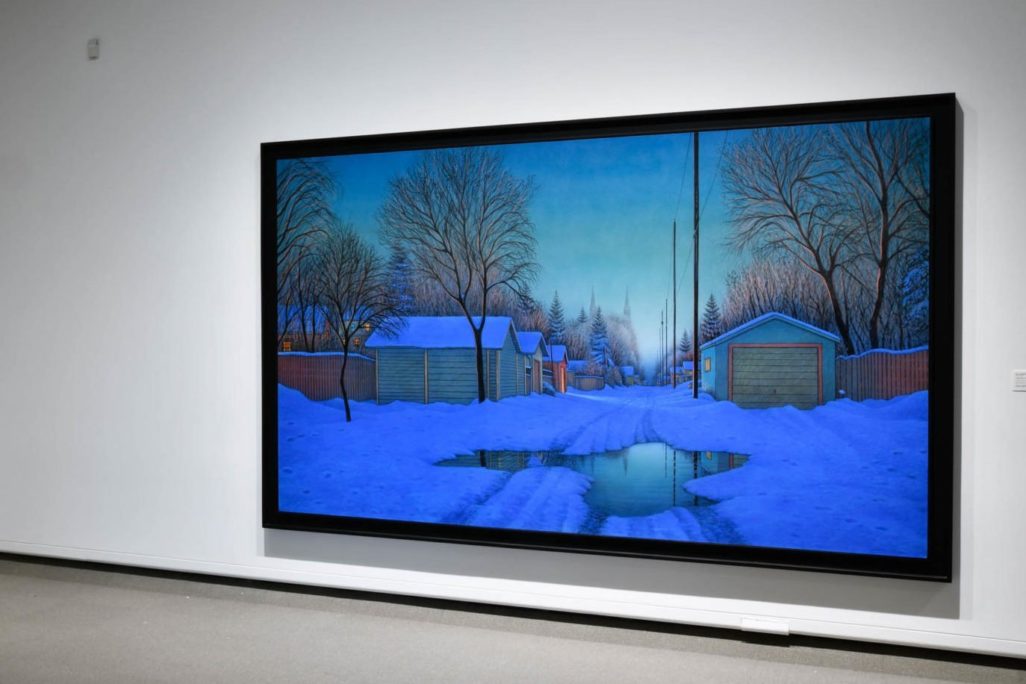About the Artwork
Guiding Light is one of many Wilf Perreault paintings that depict a back alley. This particular image is of an alley in the Cathedral neighbourhood of Regina, Saskatchewan. His interest in back alleys is related to their role as urban (city) community spaces that are often overlooked. Perrault often tells of his fond memories of looking for glass bottles in back allies with his father. He sees beauty in these tucked-away spaces and wants to capture an impression of these alleys before they are lost from memory; many new neighbourhoods are no longer built with back alleys.
Timothy Long described Wilf Perreault’s artwork: “The bottom half of the painting is like a poem, the top half is like a novel.” (https://mackenzie.art/exhibition/wilf-perreault-in-the-alley/) In fact, this particular artwork was accompanied by a poem written by Judith Krause in the catalogue of Perreault’s exhibition Wilf Perrault: In the Alley.
Light also plays an important role in Perreault’s paintings. Notice the warm glow from the windows, and the soft light coming from the twilight sky. “There is a light inside the work. It doesn’t really matter if it’s day time or night time — there’s a light that comes from within. I think the light is actually life. Somehow my job is to take that painting and make it live and breathe and exist beyond the photograph or beyond me.” (Wilf Perreault, https://mackenzie.art/exhibition/wilf-perreault-in-the-alley/)
This artwork was commissioned (specially ordered) by the Barootes family in memory of Betty Barootes and donated to the MacKenzie Art Gallery.
About the Artist
Wilf Perreault is a Francophone painter who lives and works in Regina, Saskatchewan. He was born in Albertville, Saskatchewan in 1947 and grew up in Saskatoon, Saskatchewan. In his youth, he took art lessons from his next-door neighbour, Ernest Lindner. He attended the University of Saskatchewan in Saskatoon and graduated with a Bachelor of Arts Honours degree with a major in sculpture.
After his time at university, he moved to Regina. For several years, he taught art at the high school level and painted when he could find time. His work began to sell very well, which allowed him to make the decision to change careers and paint full time.
Wilf Perreault creates beautiful paintings of everyday places that are often overlooked. He is well known for painting back alleys throughout his career, even though the styles, themes, and mediums of these paintings have changed. Within the “back alley” format, he uses new ideas and techniques that he employs to keep his work fresh and challenging.
Want to hear some poetry about Wilf’s art process and see how he takes photographs as reference for his work? Watch the trailer for the documentary The Alley Man by Jan Nowina-Zarzycki and Rob King here.
Things to Think About
- How do you engage with both the people and the spaces that make up your neighbourhood community? Do you have any interactions with this community during special events and holidays?
- Light is very important in Wilf Perrault’s artworks. Where do you see light coming from in this artwork? How does the light make you feel?
Studio Activity
Paint an outdoor evening scene of a place in your neighbourhood that’s special to you and use crayon resist to highlight light sources.
Supplies:
- Pencils and erasers
- Watercolour paper
- Watercolours
- Paint brushes
- A water cup
- Optional- google maps to look at your neighbourhood, or photos from your neighbourhood.
- Crayons in light colours
- Optional- masking tape
- Optional- thin boards or cardboard
Instructions:
Think about an outdoor spot in your neighbourhood that’s special to you. It could be somewhere you’ve spent time playing with your siblings, somewhere you played a sport, somewhere you did a family activity, your favourite street to trick-or-treat on or to see Christmas lights, or any other place that has a strong memory for you. Draw this spot lightly in pencil on your watercolour paper. You can use photos or Google Maps images to help you remember details from that space, or draw it from memory.
After you’ve finished the pencil drawing, draw over any spots that light would be coming from in crayon. The watercolours will be resisted by the crayon- they will roll right off the crayon and only colour paper that doesn’t have crayon on it. This makes it easier to keep those spots very bright. Think about which colour of crayons you choose for each light source. Is the light coming from that spot bright white, harsh blue, glowing green, or even a warm yellow or amber?
Finally, paint in your image with watercolours. You may want to tape your artwork to a large piece of cardboard or a thin board before painting to help keep it flatter.
If your paper does curl while you are working, you can press it flat after you’re finished. Very lightly spray the back of your painting with clean water and let it soak in. Sandwich your painting between a few layers of paper towel. Then sandwich all of that between some flat surfaces such as cardboard, plexiglass, or thin wooden boards. Place something heavy on top to press your artwork flat and leave it that way for several hours or overnight.
Share the painting with people in your community- your friends, family, or neighbours- and talk about the memory it represents for you! You could even write a poem to go with your artwork if you like.

